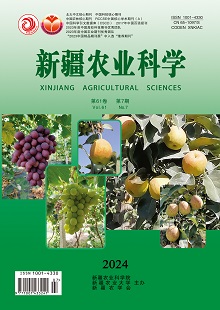【Objective】The effects of mixed sowing of alfalfa and perennial ryegrass on yield and nutritional quality under different nitrogen levels were explored, and the proportion of mixed sowing under the best nitrogen level was screened.【Methods】Alfalfa (WL525HQ) and perennial ryegrass (Toya) were used as materials, and a two-factor split-plot design was used.The nitrogen application rate was the main area, N0 : no nitrogen application ; N1 : 20% of the total nitrogen application was base fertilizer, 20% of the top dressing at branching stage, and 60% of the top dressing at budding stage ; N2 : 20% of the total nitrogen application rate was base fertilizer, 30% of the top dressing at branching stage, and 50% of the top dressing at budding stage ; the mixed sowing ratio of alfalfa (M) and perennial ryegrass (L) was 22.5 kg / hm2 and 60.0 kg / hm2, respectively.Alfalfa + perennial ryegrass 7∶3 (M7 + L3), alfalfa + perennial ryegrass 6∶4 (M6 + L4), alfalfa + perennial ryegrass 5∶5 (M5 + L5), alfalfa + perennial ryegrass 4∶6 (M4 + L6), alfalfa + perennial ryegrass 3∶7 (M3 + L7) ; the sowing amount of each plot was sowed according to the percentage of single sowing treatment, with 3 replicates.The yield and nutritional quality of each treatment were compared and analyzed.【Results】Under N0, N1 and N2 nitrogen levels, the hay yield of alfalfa and perennial ryegrass mixed sowing in different stubbles was significantly higher than that of single sowing (P<0.05), and the hay yield of M5 + L5 treatment reached 1.06 t / hm2.Under N0, N1 and N2 nitrogen levels, CP, DM, RFV, TDN and CP yield content per unit area were significantly higher than those of single sowing (P<0.05), and NDF and ADF were significantly lower than those of single sowing (P<0.05).Under N1 nitrogen level, the CP content of M7 + L3 treatment was the highest (P < 0.05), and increased first and then decreased with the increase of the proportion of perennial ryegrass.The CP content of M5 + L5 treatment was the highest, and the DM content of M6 + L4 treatment was the highest (P< 0.05).The RFV and TDN of M5 + L5 treatment were the highest (P < 0.05).The contents of NDF and ADF in M5 + L5 treatment were the lowest (P < 0.05), and decreased first and then increased with the increase of the proportion of perennial ryegrass.【Conclusion】The yield, CP, DM, RFV, TDN and crude protein content per unit area of mixed sowing of alfalfa and perennial ryegrass at different nitrogen levels were higher than those of monoculture, and the contents of NDF and ADF were lower than those of monoculture.The optimum ratio of mixed sowing of alfalfa and perennial ryegrass was 5∶5.The annual hay yield reached 1.06 t / hm2, the crude protein content was 26.05%, and the NDF and ADF were 26.03% and 26.03%, respectively; The forage yield and nutritional quality of nitrogen treatment were higher than that of the control group, and the nitrogen utilization rate of perennial ryegrass in mixed sowing increased with the increase of its proportion.Among them, 20% of the total nitrogen application rate (100kg / hm2) was the base fertilizer, 20% of the topdressing at the branching stage, and 60% of the topdressing at the budding stage was the best.

